
- Foundations
- Write Paper

Search form
- Experiments
- Anthropology
- Self-Esteem
- Social Anxiety
- Survey Guide >
Questionnaire Checklist
After creating your questionnaire, you will need to check and review the outline of the survey, the questions being asked, and the response options for the respondents. To test the efficiency of the questionnaire, here is a questionnaire checklist that will serve as your guide.
This article is a part of the guide:
- Response Scales
- Example - Questionnaire
- Advantages and Disadvantages
- Surveys and Questionnaires - Guide
- Types of Surveys
Browse Full Outline
- 1 Surveys and Questionnaires - Guide
- 2.1 Research and Surveys
- 2.2 Advantages and Disadvantages
- 2.3 Survey Design
- 2.4 Sampling
- 3.1 Defining Goals
- 4.1 Survey Layout
- 4.2 Types of Questions
- 4.3 Constructing Questions
- 4.4 Response Formats
- 4.5 Response Scales
- 5.1 Selecting Method
- 5.2 Personal Interview
- 5.3 Telephone
- 5.4.1 Preparing Online Surveys
- 5.4.2 Online Tools
- 5.5 Focus Group
- 5.6 Panel Study
- 6.1 Pilot Survey
- 6.2 Increasing Response Rates
- 7.1 Analysis and Data
- 7.2 Conclusion
- 7.3 Presenting the Results
- 8 Example - Questionnaire
- 9 Checklist
The following questionnaire checklist includes three sections:
- the outline and format
- the questions and
- pre-test or pilot testing.
You may print this and place a checkmark if you think you have successfully accomplished each item on the checklist.

1. The Outline and Format
A. introduction to the questionnaire.
- Title of the Study
- Duration of survey and length of questionnaire
- Guarantee of confidentiality
- Brief information about the company or organization
- Incentive Information (if any)
B. Demographic Data
- Respondent’s Name (This could be optional.)
- Age, Gender, etc.
C. Question Format
- The first question is a closed-ended question (answerable by Yes or No).
- Questions are arranged from general to specific.
- Sensitive questions are at the end of the questionnarie.
- Questions are grouped together according to the topic.
- The directions on how to answer are placed before the questions.
- The rating scale is written before the questions.
- The response options are placed vertically, except for tabulated questions.
See also: Survey Response Scales , Survey Response Formats .
D. End of Questionnaire
- A “Thank You” or any expression of gratitude to the respondent
- Information on knowing the survey results

2. The Questions
- The questions are concise and simple.
- All the questions do not contain any terminologies, acronyms or jargons that are unfamiliar to the respondents.
- The first 5 questions verify whether the respondent is eligible to continue the survey or not.
- All questions point to the survey goals.
- All possible response options or an “Other” option are included in each question.
- The respondent may or may not answer sensitive questions by placing a “Prefer not to answer” option.
- A midpoint response option such as “Average”, “Sometimes" or "Neutral" is included on the rating scale used.
- Most questions are closed-ended.
- Open-ended questions are voluntary.
See also: Constructing Survey Questions , Types of Survey Questions , Questionnaire Layout .
3. Pre-Test
- The survey questionnaire has been sent to friends, colleagues or experts to validate the wording and timing.
- The survey questionnaire has been answered by few survey respondents from the target population.
- Five (5) close-ended questions are answerable within one minute, while two (2) open-ended questions are answerable within one minute.
- The survey takes a maximum of 10 minutes to complete.
- Appropriate revisions of the questionnaire are done.
See also: Pilot Survey .
- Psychology 101
- Flags and Countries
- Capitals and Countries
Sarah Mae Sincero (Mar 16, 2012). Questionnaire Checklist. Retrieved Apr 09, 2024 from Explorable.com: https://explorable.com/questionnaire-checklist
You Are Allowed To Copy The Text
The text in this article is licensed under the Creative Commons-License Attribution 4.0 International (CC BY 4.0) .
This means you're free to copy, share and adapt any parts (or all) of the text in the article, as long as you give appropriate credit and provide a link/reference to this page.
That is it. You don't need our permission to copy the article; just include a link/reference back to this page. You can use it freely (with some kind of link), and we're also okay with people reprinting in publications like books, blogs, newsletters, course-material, papers, wikipedia and presentations (with clear attribution).
Related articles
Questionnaire Example
Want to stay up to date? Follow us!
Save this course for later.
Don't have time for it all now? No problem, save it as a course and come back to it later.
Footer bottom
- Privacy Policy

- Subscribe to our RSS Feed
- Like us on Facebook
- Follow us on Twitter
An official website of the United States government
The .gov means it’s official. Federal government websites often end in .gov or .mil. Before sharing sensitive information, make sure you’re on a federal government site.
The site is secure. The https:// ensures that you are connecting to the official website and that any information you provide is encrypted and transmitted securely.
- Publications
- Account settings
Preview improvements coming to the PMC website in October 2024. Learn More or Try it out now .
- Advanced Search
- Journal List
- Perspect Clin Res
- v.14(3); Jul-Sep 2023
- PMC10405529
Designing and validating a research questionnaire - Part 1
Priya ranganathan.
Department of Anaesthesiology, Tata Memorial Centre, Homi Bhabha National Institute, Mumbai, Maharashtra, India
Carlo Caduff
1 Department of Global Health and Social Medicine, King’s College London, London, United Kingdom
Questionnaires are often used as part of research studies to collect data from participants. However, the information obtained through a questionnaire is dependent on how it has been designed, used, and validated. In this article, we look at the types of research questionnaires, their applications and limitations, and how a new questionnaire is developed.
INTRODUCTION
In research studies, questionnaires are commonly used as data collection tools, either as the only source of information or in combination with other techniques in mixed-method studies. However, the quality and accuracy of data collected using a questionnaire depend on how it is designed, used, and validated. In this two-part series, we discuss how to design (part 1) and how to use and validate (part 2) a research questionnaire. It is important to emphasize that questionnaires seek to gather information from other people and therefore entail a social relationship between those who are doing the research and those who are being researched. This social relationship comes with an obligation to learn from others , an obligation that goes beyond the purely instrumental rationality of gathering data. In that sense, we underscore that any research method is not simply a tool but a situation, a relationship, a negotiation, and an encounter. This points to both ethical questions (what is the relationship between the researcher and the researched?) and epistemological ones (what are the conditions under which we can know something?).
At the start of any kind of research project, it is crucial to select the right methodological approach. What is the research question, what is the research object, and what can a questionnaire realistically achieve? Not every research question and not every research object are suitable to the questionnaire as a method. Questionnaires can only provide certain kinds of empirical evidence and it is thus important to be aware of the limitations that are inherent in any kind of methodology.
WHAT IS A RESEARCH QUESTIONNAIRE?
A research questionnaire can be defined as a data collection tool consisting of a series of questions or items that are used to collect information from respondents and thus learn about their knowledge, opinions, attitudes, beliefs, and behavior and informed by a positivist philosophy of the natural sciences that consider methods mainly as a set of rules for the production of knowledge; questionnaires are frequently used instrumentally as a standardized and standardizing tool to ask a set of questions to participants. Outside of such a positivist philosophy, questionnaires can be seen as an encounter between the researcher and the researched, where knowledge is not simply gathered but negotiated through a distinct form of communication that is the questionnaire.
STRENGTHS AND LIMITATIONS OF QUESTIONNAIRES
A questionnaire may not always be the most appropriate way of engaging with research participants and generating knowledge that is needed for a research study. Questionnaires have advantages that have made them very popular, especially in quantitative studies driven by a positivist philosophy: they are a low-cost method for the rapid collection of large amounts of data, even from a wide sample. They are practical, can be standardized, and allow comparison between groups and locations. However, it is important to remember that a questionnaire only captures the information that the method itself (as the structured relationship between the researcher and the researched) allows for and that the respondents are willing to provide. For example, a questionnaire on diet captures what the respondents say they eat and not what they are eating. The problem of social desirability emerges precisely because the research process itself involves a social relationship. This means that respondents may often provide socially acceptable and idealized answers, particularly in relation to sensitive questions, for example, alcohol consumption, drug use, and sexual practices. Questionnaires are most useful for studies investigating knowledge, beliefs, values, self-understandings, and self-perceptions that reflect broader social, cultural, and political norms that may well diverge from actual practices.
TYPES OF RESEARCH QUESTIONNAIRES
Research questionnaires may be classified in several ways:
Depending on mode of administration
Research questionnaires may be self-administered (by the research participant) or researcher administered. Self-administered (also known as self-reported or self-completed) questionnaires are designed to be completed by respondents without assistance from a researcher. Self-reported questionnaires may be administered to participants directly during hospital or clinic visits, mailed through the post or E-mail, or accessed through websites. This technique allows respondents to answer at their own pace and simplifies research costs and logistics. The anonymity offered by self-reporting may facilitate more accurate answers. However, the disadvantages are that there may be misinterpretations of questions and low response rates. Significantly, relevant context information is missing to make sense of the answers provided. Researcher-reported (or interviewer-reported) questionnaires may be administered face-to-face or through remote techniques such as telephone or videoconference and are associated with higher response rates. They allow the researcher to have a better understanding of how the data are collected and how answers are negotiated, but are more resource intensive and require more training from the researchers.
The choice between self-administered and researcher-administered questionnaires depends on various factors such as the characteristics of the target audience (e.g., literacy and comprehension level and ability to use technology), costs involved, and the need for confidentiality/privacy.
Depending on the format of the questions
Research questionnaires can have structured or semi-structured formats. Semi-structured questionnaires allow respondents to answer more freely and on their terms, with no restrictions on their responses. They allow for unusual or surprising responses and are useful to explore and discover a range of answers to determine common themes. Typically, the analysis of responses to open-ended questions is more complex and requires coding and analysis. In contrast, structured questionnaires provide a predefined set of responses for the participant to choose from. The use of standard items makes the questionnaire easier to complete and allows quick aggregation, quantification, and analysis of the data. However, structured questionnaires can be restrictive if the scope of responses is limited and may miss potential answers. They also may suggest answers that respondents may not have considered before. Respondents may be forced to fit their answers into the predetermined format and may not be able to express personal views and say what they really want to say or think. In general, this type of questionnaire can turn the research process into a mechanical, anonymous survey with little incentive for participants to feel engaged, understood, and taken seriously.
STRUCTURED QUESTIONS: FORMATS
Some examples of close-ended questions include:
e.g., Please indicate your marital status:
- Prefer not to say.
e.g., Describe your areas of work (circle or tick all that apply):
- Clinical service
- Administration
- Strongly agree
- Strongly disagree.
- Numerical scales: Please rate your current pain on a scale of 1–10 where 1 is no pain and 10 is the worst imaginable pain
- Symbolic scales: For example, the Wong-Baker FACES scale to rate pain in older children
- Ranking: Rank the following cities as per the quality of public health care, where 1 is the best and 5 is the worst.
A matrix questionnaire consists of a series of rows with items to be answered with a series of columns providing the same answer options. This is an efficient way of getting the respondent to provide answers to multiple questions. The EORTC QLQ-C30 is an example of a matrix questionnaire.[ 1 ]
For a more detailed review of the types of research questions, readers are referred to a paper by Boynton and Greenhalgh.[ 2 ]
USING PRE-EXISTING QUESTIONNAIRES VERSUS DEVELOPING A NEW QUESTIONNAIRE
Before developing a questionnaire for a research study, a researcher can check whether there are any preexisting-validated questionnaires that might be adapted and used for the study. The use of validated questionnaires saves time and resources needed to design a new questionnaire and allows comparability between studies.
However, certain aspects need to be kept in mind: is the population/context/purpose for which the original questionnaire was designed similar to the new study? Is cross-cultural adaptation required? Are there any permission needed to use the questionnaire? In many situations, the development of a new questionnaire may be more appropriate given that any research project entails both methodological and epistemological questions: what is the object of knowledge and what are the conditions under which it can be known? It is important to understand that the standardizing nature of questionnaires contributes to the standardization of objects of knowledge. Thus, the seeming similarity in the object of study across diverse locations may be an artifact of the method. Whatever method one uses, it will always operate as the ground on which the object of study is known.
DESIGNING A NEW RESEARCH QUESTIONNAIRE
Once the researcher has decided to design a new questionnaire, several steps should be considered:
Gathering content
It creates a conceptual framework to identify all relevant areas for which the questionnaire will be used to collect information. This may require a scoping review of the published literature, appraising other questionnaires on similar topics, or the use of focus groups to identify common themes.
Create a list of questions
Questions need to be carefully formulated with attention to language and wording to avoid ambiguity and misinterpretation. Table 1 lists a few examples of poorlyworded questions that could have been phrased in a more appropriate manner. Other important aspects to be noted are:
Examples of poorly phrased questions in a research questionnaire
- Provide a brief introduction to the research study along with instructions on how to complete the questionnaire
- Allow respondents to indicate levels of intensity in their replies, so that they are not forced into “yes” or “no” answers where intensity of feeling may be more appropriate
- Collect specific and detailed data wherever possible – this can be coded into categories. For example, age can be captured in years and later classified as <18 years, 18–45 years, 46 years, and above. The reverse is not possible
- Avoid technical terms, slang, and abbreviations. Tailor the reading level to the expected education level of respondents
- The format of the questionnaire should be attractive with different sections for various subtopics. The font should be large and easy to read, especially if the questionnaire is targeted at the elderly
- Question sequence: questions should be arranged from general to specific, from easy to difficult, from facts to opinions, and sensitive topics should be introduced later in the questionnaire.[ 3 ] Usually, demographic details are captured initially followed by questions on other aspects
- Use contingency questions: these are questions which need to be answered only by a subgroup of the respondents who provide a particular answer to a previous question. This ensures that participants only respond to relevant sections of the questionnaire, for example, Do you smoke? If yes, then how long have you been smoking? If not, then please go to the next section.
TESTING A QUESTIONNAIRE
A questionnaire needs to be valid and reliable, and therefore, any new questionnaire needs to be pilot tested in a small sample of respondents who are representative of the larger population. In addition to validity and reliability, pilot testing provides information on the time taken to complete the questionnaire and whether any questions are confusing or misleading and need to be rephrased. Validity indicates that the questionnaire measures what it claims to measure – this means taking into consideration the limitations that come with any questionnaire-based study. Reliability means that the questionnaire yields consistent responses when administered repeatedly even by different researchers, and any variations in the results are due to actual differences between participants and not because of problems with the interpretation of the questions or their responses. In the next article in this series, we will discuss methods to determine the reliability and validity of a questionnaire.
Financial support and sponsorship
Conflicts of interest.
There are no conflicts of interest.
- Privacy Policy
Buy Me a Coffee

Home » Questionnaire – Definition, Types, and Examples
Questionnaire – Definition, Types, and Examples
Table of Contents

Questionnaire
Definition:
A Questionnaire is a research tool or survey instrument that consists of a set of questions or prompts designed to gather information from individuals or groups of people.
It is a standardized way of collecting data from a large number of people by asking them a series of questions related to a specific topic or research objective. The questions may be open-ended or closed-ended, and the responses can be quantitative or qualitative. Questionnaires are widely used in research, marketing, social sciences, healthcare, and many other fields to collect data and insights from a target population.
History of Questionnaire
The history of questionnaires can be traced back to the ancient Greeks, who used questionnaires as a means of assessing public opinion. However, the modern history of questionnaires began in the late 19th century with the rise of social surveys.
The first social survey was conducted in the United States in 1874 by Francis A. Walker, who used a questionnaire to collect data on labor conditions. In the early 20th century, questionnaires became a popular tool for conducting social research, particularly in the fields of sociology and psychology.
One of the most influential figures in the development of the questionnaire was the psychologist Raymond Cattell, who in the 1940s and 1950s developed the personality questionnaire, a standardized instrument for measuring personality traits. Cattell’s work helped establish the questionnaire as a key tool in personality research.
In the 1960s and 1970s, the use of questionnaires expanded into other fields, including market research, public opinion polling, and health surveys. With the rise of computer technology, questionnaires became easier and more cost-effective to administer, leading to their widespread use in research and business settings.
Today, questionnaires are used in a wide range of settings, including academic research, business, healthcare, and government. They continue to evolve as a research tool, with advances in computer technology and data analysis techniques making it easier to collect and analyze data from large numbers of participants.
Types of Questionnaire
Types of Questionnaires are as follows:
Structured Questionnaire
This type of questionnaire has a fixed format with predetermined questions that the respondent must answer. The questions are usually closed-ended, which means that the respondent must select a response from a list of options.
Unstructured Questionnaire
An unstructured questionnaire does not have a fixed format or predetermined questions. Instead, the interviewer or researcher can ask open-ended questions to the respondent and let them provide their own answers.
Open-ended Questionnaire
An open-ended questionnaire allows the respondent to answer the question in their own words, without any pre-determined response options. The questions usually start with phrases like “how,” “why,” or “what,” and encourage the respondent to provide more detailed and personalized answers.
Close-ended Questionnaire
In a closed-ended questionnaire, the respondent is given a set of predetermined response options to choose from. This type of questionnaire is easier to analyze and summarize, but may not provide as much insight into the respondent’s opinions or attitudes.
Mixed Questionnaire
A mixed questionnaire is a combination of open-ended and closed-ended questions. This type of questionnaire allows for more flexibility in terms of the questions that can be asked, and can provide both quantitative and qualitative data.
Pictorial Questionnaire:
In a pictorial questionnaire, instead of using words to ask questions, the questions are presented in the form of pictures, diagrams or images. This can be particularly useful for respondents who have low literacy skills, or for situations where language barriers exist. Pictorial questionnaires can also be useful in cross-cultural research where respondents may come from different language backgrounds.
Types of Questions in Questionnaire
The types of Questions in Questionnaire are as follows:
Multiple Choice Questions
These questions have several options for participants to choose from. They are useful for getting quantitative data and can be used to collect demographic information.
- a. Red b . Blue c. Green d . Yellow
Rating Scale Questions
These questions ask participants to rate something on a scale (e.g. from 1 to 10). They are useful for measuring attitudes and opinions.
- On a scale of 1 to 10, how likely are you to recommend this product to a friend?
Open-Ended Questions
These questions allow participants to answer in their own words and provide more in-depth and detailed responses. They are useful for getting qualitative data.
- What do you think are the biggest challenges facing your community?
Likert Scale Questions
These questions ask participants to rate how much they agree or disagree with a statement. They are useful for measuring attitudes and opinions.
How strongly do you agree or disagree with the following statement:
“I enjoy exercising regularly.”
- a . Strongly Agree
- c . Neither Agree nor Disagree
- d . Disagree
- e . Strongly Disagree
Demographic Questions
These questions ask about the participant’s personal information such as age, gender, ethnicity, education level, etc. They are useful for segmenting the data and analyzing results by demographic groups.
- What is your age?
Yes/No Questions
These questions only have two options: Yes or No. They are useful for getting simple, straightforward answers to a specific question.
Have you ever traveled outside of your home country?
Ranking Questions
These questions ask participants to rank several items in order of preference or importance. They are useful for measuring priorities or preferences.
Please rank the following factors in order of importance when choosing a restaurant:
- a. Quality of Food
- c. Ambiance
- d. Location
Matrix Questions
These questions present a matrix or grid of options that participants can choose from. They are useful for getting data on multiple variables at once.
Dichotomous Questions
These questions present two options that are opposite or contradictory. They are useful for measuring binary or polarized attitudes.
Do you support the death penalty?
How to Make a Questionnaire
Step-by-Step Guide for Making a Questionnaire:
- Define your research objectives: Before you start creating questions, you need to define the purpose of your questionnaire and what you hope to achieve from the data you collect.
- Choose the appropriate question types: Based on your research objectives, choose the appropriate question types to collect the data you need. Refer to the types of questions mentioned earlier for guidance.
- Develop questions: Develop clear and concise questions that are easy for participants to understand. Avoid leading or biased questions that might influence the responses.
- Organize questions: Organize questions in a logical and coherent order, starting with demographic questions followed by general questions, and ending with specific or sensitive questions.
- Pilot the questionnaire : Test your questionnaire on a small group of participants to identify any flaws or issues with the questions or the format.
- Refine the questionnaire : Based on feedback from the pilot, refine and revise the questionnaire as necessary to ensure that it is valid and reliable.
- Distribute the questionnaire: Distribute the questionnaire to your target audience using a method that is appropriate for your research objectives, such as online surveys, email, or paper surveys.
- Collect and analyze data: Collect the completed questionnaires and analyze the data using appropriate statistical methods. Draw conclusions from the data and use them to inform decision-making or further research.
- Report findings: Present your findings in a clear and concise report, including a summary of the research objectives, methodology, key findings, and recommendations.
Questionnaire Administration Modes
There are several modes of questionnaire administration. The choice of mode depends on the research objectives, sample size, and available resources. Some common modes of administration include:
- Self-administered paper questionnaires: Participants complete the questionnaire on paper, either in person or by mail. This mode is relatively low cost and easy to administer, but it may result in lower response rates and greater potential for errors in data entry.
- Online questionnaires: Participants complete the questionnaire on a website or through email. This mode is convenient for both researchers and participants, as it allows for fast and easy data collection. However, it may be subject to issues such as low response rates, lack of internet access, and potential for fraudulent responses.
- Telephone surveys: Trained interviewers administer the questionnaire over the phone. This mode allows for a large sample size and can result in higher response rates, but it is also more expensive and time-consuming than other modes.
- Face-to-face interviews : Trained interviewers administer the questionnaire in person. This mode allows for a high degree of control over the survey environment and can result in higher response rates, but it is also more expensive and time-consuming than other modes.
- Mixed-mode surveys: Researchers use a combination of two or more modes to administer the questionnaire, such as using online questionnaires for initial screening and following up with telephone interviews for more detailed information. This mode can help overcome some of the limitations of individual modes, but it requires careful planning and coordination.
Example of Questionnaire
Title of the Survey: Customer Satisfaction Survey
Introduction:
We appreciate your business and would like to ensure that we are meeting your needs. Please take a few minutes to complete this survey so that we can better understand your experience with our products and services. Your feedback is important to us and will help us improve our offerings.
Instructions:
Please read each question carefully and select the response that best reflects your experience. If you have any additional comments or suggestions, please feel free to include them in the space provided at the end of the survey.
1. How satisfied are you with our product quality?
- Very satisfied
- Somewhat satisfied
- Somewhat dissatisfied
- Very dissatisfied
2. How satisfied are you with our customer service?
3. How satisfied are you with the price of our products?
4. How likely are you to recommend our products to others?
- Very likely
- Somewhat likely
- Somewhat unlikely
- Very unlikely
5. How easy was it to find the information you were looking for on our website?
- Somewhat easy
- Somewhat difficult
- Very difficult
6. How satisfied are you with the overall experience of using our products and services?
7. Is there anything that you would like to see us improve upon or change in the future?
…………………………………………………………………………………………………………………………..
Conclusion:
Thank you for taking the time to complete this survey. Your feedback is valuable to us and will help us improve our products and services. If you have any further comments or concerns, please do not hesitate to contact us.
Applications of Questionnaire
Some common applications of questionnaires include:
- Research : Questionnaires are commonly used in research to gather information from participants about their attitudes, opinions, behaviors, and experiences. This information can then be analyzed and used to draw conclusions and make inferences.
- Healthcare : In healthcare, questionnaires can be used to gather information about patients’ medical history, symptoms, and lifestyle habits. This information can help healthcare professionals diagnose and treat medical conditions more effectively.
- Marketing : Questionnaires are commonly used in marketing to gather information about consumers’ preferences, buying habits, and opinions on products and services. This information can help businesses develop and market products more effectively.
- Human Resources: Questionnaires are used in human resources to gather information from job applicants, employees, and managers about job satisfaction, performance, and workplace culture. This information can help organizations improve their hiring practices, employee retention, and organizational culture.
- Education : Questionnaires are used in education to gather information from students, teachers, and parents about their perceptions of the educational experience. This information can help educators identify areas for improvement and develop more effective teaching strategies.
Purpose of Questionnaire
Some common purposes of questionnaires include:
- To collect information on attitudes, opinions, and beliefs: Questionnaires can be used to gather information on people’s attitudes, opinions, and beliefs on a particular topic. For example, a questionnaire can be used to gather information on people’s opinions about a particular political issue.
- To collect demographic information: Questionnaires can be used to collect demographic information such as age, gender, income, education level, and occupation. This information can be used to analyze trends and patterns in the data.
- To measure behaviors or experiences: Questionnaires can be used to gather information on behaviors or experiences such as health-related behaviors or experiences, job satisfaction, or customer satisfaction.
- To evaluate programs or interventions: Questionnaires can be used to evaluate the effectiveness of programs or interventions by gathering information on participants’ experiences, opinions, and behaviors.
- To gather information for research: Questionnaires can be used to gather data for research purposes on a variety of topics.
When to use Questionnaire
Here are some situations when questionnaires might be used:
- When you want to collect data from a large number of people: Questionnaires are useful when you want to collect data from a large number of people. They can be distributed to a wide audience and can be completed at the respondent’s convenience.
- When you want to collect data on specific topics: Questionnaires are useful when you want to collect data on specific topics or research questions. They can be designed to ask specific questions and can be used to gather quantitative data that can be analyzed statistically.
- When you want to compare responses across groups: Questionnaires are useful when you want to compare responses across different groups of people. For example, you might want to compare responses from men and women, or from people of different ages or educational backgrounds.
- When you want to collect data anonymously: Questionnaires can be useful when you want to collect data anonymously. Respondents can complete the questionnaire without fear of judgment or repercussions, which can lead to more honest and accurate responses.
- When you want to save time and resources: Questionnaires can be more efficient and cost-effective than other methods of data collection such as interviews or focus groups. They can be completed quickly and easily, and can be analyzed using software to save time and resources.
Characteristics of Questionnaire
Here are some of the characteristics of questionnaires:
- Standardization : Questionnaires are standardized tools that ask the same questions in the same order to all respondents. This ensures that all respondents are answering the same questions and that the responses can be compared and analyzed.
- Objectivity : Questionnaires are designed to be objective, meaning that they do not contain leading questions or bias that could influence the respondent’s answers.
- Predefined responses: Questionnaires typically provide predefined response options for the respondents to choose from, which helps to standardize the responses and make them easier to analyze.
- Quantitative data: Questionnaires are designed to collect quantitative data, meaning that they provide numerical or categorical data that can be analyzed using statistical methods.
- Convenience : Questionnaires are convenient for both the researcher and the respondents. They can be distributed and completed at the respondent’s convenience and can be easily administered to a large number of people.
- Anonymity : Questionnaires can be anonymous, which can encourage respondents to answer more honestly and provide more accurate data.
- Reliability : Questionnaires are designed to be reliable, meaning that they produce consistent results when administered multiple times to the same group of people.
- Validity : Questionnaires are designed to be valid, meaning that they measure what they are intended to measure and are not influenced by other factors.
Advantage of Questionnaire
Some Advantage of Questionnaire are as follows:
- Standardization: Questionnaires allow researchers to ask the same questions to all participants in a standardized manner. This helps ensure consistency in the data collected and eliminates potential bias that might arise if questions were asked differently to different participants.
- Efficiency: Questionnaires can be administered to a large number of people at once, making them an efficient way to collect data from a large sample.
- Anonymity: Participants can remain anonymous when completing a questionnaire, which may make them more likely to answer honestly and openly.
- Cost-effective: Questionnaires can be relatively inexpensive to administer compared to other research methods, such as interviews or focus groups.
- Objectivity: Because questionnaires are typically designed to collect quantitative data, they can be analyzed objectively without the influence of the researcher’s subjective interpretation.
- Flexibility: Questionnaires can be adapted to a wide range of research questions and can be used in various settings, including online surveys, mail surveys, or in-person interviews.
Limitations of Questionnaire
Limitations of Questionnaire are as follows:
- Limited depth: Questionnaires are typically designed to collect quantitative data, which may not provide a complete understanding of the topic being studied. Questionnaires may miss important details and nuances that could be captured through other research methods, such as interviews or observations.
- R esponse bias: Participants may not always answer questions truthfully or accurately, either because they do not remember or because they want to present themselves in a particular way. This can lead to response bias, which can affect the validity and reliability of the data collected.
- Limited flexibility: While questionnaires can be adapted to a wide range of research questions, they may not be suitable for all types of research. For example, they may not be appropriate for studying complex phenomena or for exploring participants’ experiences and perceptions in-depth.
- Limited context: Questionnaires typically do not provide a rich contextual understanding of the topic being studied. They may not capture the broader social, cultural, or historical factors that may influence participants’ responses.
- Limited control : Researchers may not have control over how participants complete the questionnaire, which can lead to variations in response quality or consistency.
About the author
Muhammad Hassan
Researcher, Academic Writer, Web developer
You may also like

Case Study – Methods, Examples and Guide

Observational Research – Methods and Guide

Quantitative Research – Methods, Types and...

Qualitative Research Methods

Explanatory Research – Types, Methods, Guide

Survey Research – Types, Methods, Examples
- Skip to main content
- Skip to primary sidebar
- Skip to footer
- QuestionPro

- Solutions Industries Gaming Automotive Sports and events Education Government Travel & Hospitality Financial Services Healthcare Cannabis Technology Use Case NPS+ Communities Audience Contactless surveys Mobile LivePolls Member Experience GDPR Positive People Science 360 Feedback Surveys
- Resources Blog eBooks Survey Templates Case Studies Training Help center
Home Surveys Questionnaire
21 Questionnaire Templates: Examples and Samples

Questionnaire: Definition
A questionnaire is defined a market research instrument that consists of questions or prompts to elicit and collect responses from a sample of respondents. A questionnaire is typically a mix of open-ended questions and close-ended questions ; the latter allowing for respondents to enlist their views in detail.
A questionnaire can be used in both, qualitative market research as well as quantitative market research with the use of different types of questions .
LEARN ABOUT: Open-Ended Questions
Types of Questionnaires
We have learnt that a questionnaire could either be structured or free-flow. To explain this better:
- Structured Questionnaires: A structured questionnaires helps collect quantitative data . In this case, the questionnaire is designed in a way that it collects very specific type of information. It can be used to initiate a formal enquiry on collect data to prove or disprove a prior hypothesis.
- Unstructured Questionnaires: An unstructured questionnaire collects qualitative data . The questionnaire in this case has a basic structure and some branching questions but nothing that limits the responses of a respondent. The questions are more open-ended.
LEARN ABOUT: Structured Question
Types of Questions used in a Questionnaire
A questionnaire can consist of many types of questions . Some of the commonly and widely used question types though, are:
- Open-Ended Questions: One of the commonly used question type in questionnaire is an open-ended question . These questions help collect in-depth data from a respondent as there is a huge scope to respond in detail.
- Dichotomous Questions: The dichotomous question is a “yes/no” close-ended question . This question is generally used in case of the need of basic validation. It is the easiest question type in a questionnaire.
- Multiple-Choice Questions: An easy to administer and respond to, question type in a questionnaire is the multiple-choice question . These questions are close-ended questions with either a single select multiple choice question or a multiple select multiple choice question. Each multiple choice question consists of an incomplete stem (question), right answer or answers, close alternatives, distractors and incorrect answers. Depending on the objective of the research, a mix of the above option types can be used.
- Net Promoter Score (NPS) Question: Another commonly used question type in a questionnaire is the Net Promoter Score (NPS) Question where one single question collects data on the referencability of the research topic in question.
- Scaling Questions: Scaling questions are widely used in a questionnaire as they make responding to the questionnaire, very easy. These questions are based on the principles of the 4 measurement scales – nominal, ordinal, interval and ratio .
Questionnaires help enterprises collect valuable data to help them make well-informed business decisions. There are powerful tools available in the market that allows using multiple question types, ready to use survey format templates, robust analytics, and many more features to conduct comprehensive market research.
LEARN ABOUT: course evaluation survey examples
For example, an enterprise wants to conduct market research to understand what pricing would be best for their new product to capture a higher market share. In such a case, a questionnaire for competitor analysis can be sent to the targeted audience using a powerful market research survey software which can help the enterprise conduct 360 market research that will enable them to make strategic business decisions.
Now that we have learned what a questionnaire is and its use in market research , some examples and samples of widely used questionnaire templates on the QuestionPro platform are as below:
LEARN ABOUT: Speaker evaluation form
Customer Questionnaire Templates: Examples and Samples
QuestionPro specializes in end-to-end Customer Questionnaire Templates that can be used to evaluate a customer journey right from indulging with a brand to the continued use and referenceability of the brand. These templates form excellent samples to form your own questionnaire and begin testing your customer satisfaction and experience based on customer feedback.
LEARN ABOUT: Structured Questionnaire
USE THIS FREE TEMPLATE
Employee & Human Resource (HR) Questionnaire Templates: Examples and Samples
QuestionPro has built a huge repository of employee questionnaires and HR questionnaires that can be readily deployed to collect feedback from the workforce on an organization on multiple parameters like employee satisfaction, benefits evaluation, manager evaluation , exit formalities etc. These templates provide a holistic overview of collecting actionable data from employees.
Community Questionnaire Templates: Examples and Samples
The QuestionPro repository of community questionnaires helps collect varied data on all community aspects. This template library includes popular questionnaires such as community service, demographic questionnaires, psychographic questionnaires, personal questionnaires and much more.
Academic Evaluation Questionnaire Templates: Examples and Samples
Another vastly used section of QuestionPro questionnaire templates are the academic evaluation questionnaires . These questionnaires are crafted to collect in-depth data about academic institutions and the quality of teaching provided, extra-curricular activities etc and also feedback about other educational activities.
MORE LIKE THIS

Event Feedback Software: Top 11 Best in 2024
Apr 9, 2024

Top 10 Free Market Research Tools to Boost Your Business

Best 15 Behavior Analytics Tools to Explore Your User Actions
Apr 8, 2024

Top 7 Concept Testing Tools to Elevate Your Ideas in 2024
Other categories.
- Academic Research
- Artificial Intelligence
- Assessments
- Brand Awareness
- Case Studies
- Communities
- Consumer Insights
- Customer effort score
- Customer Engagement
- Customer Experience
- Customer Loyalty
- Customer Research
- Customer Satisfaction
- Employee Benefits
- Employee Engagement
- Employee Retention
- Friday Five
- General Data Protection Regulation
- Insights Hub
- Life@QuestionPro
- Market Research
- Mobile diaries
- Mobile Surveys
- New Features
- Online Communities
- Question Types
- Questionnaire
- QuestionPro Products
- Release Notes
- Research Tools and Apps
- Revenue at Risk
- Survey Templates
- Training Tips
- Uncategorized
- Video Learning Series
- What’s Coming Up
- Workforce Intelligence

- Request new password
- Create a new account
The Essential Guide to Doing Your Research Project
Student resources, checklist for surveys, a: planning – thinking through ‘who’, ‘where’, ‘when’, ‘how’ and ‘what’. have you considered:.
☑ Who you plan to speak about (population) – and gather data from (sample)
☑ How you will reach your sample
☑ How you plan to control your biases
☑ How you might develop the skills/resources needed to carry out your survey, i.e.) statistics proficiency
☑ Ethics/ethics approval
☑ The aspects of your research question that can be answered through a questionnaire.
☑ Details – distribution, reminders, response rates, and data management
☑ Contingencies – that is, having a back-up plan ready to go if response rates are low
B: Developing your questionnaire. Have you:
☑ Operationalized your concepts
☑ Explored existing survey instruments
☑ Drafted questions
☑ Decide on response categories
☑ Considered whether your question are ambiguous, leading, confronting, offensive, based on unwarranted assumptions, double-barreled, or pretentious
☑ Rewritten your questions
☑ Appropriately ordered your questions
☑ Written instructions
☑ Worked on layout
☑ Written a cover letter/ introductory statement
C: Piloting. Have you:
☑ Done a run-through
☑ Reflected on the piloting process
☑ Sought feedback
☑ Trialled your stats package
D: Modifying. Have you:
☑ Made appropriate modifications
☑ Considered revisiting your planning, development and piloting process (necessary if modifications are substantial)
E: Implementing. Have you:
☑ Distributed your questionnaires. Be sure to include instructions for return (address and return date) and possibly a self-addressed stamped envelope
☑ Sent reminder letters – send these out if response rates are low
☑ Initiated a low response rate plan – put this into action if not enough data has been gathered by your deadline
F: Managing and analysing. Have you:
☑ Organized/collated your data
☑ Analysed your data. Most survey data will be analysed statistically, but you will need to engage in thematic analysis for any open-ended questions
Have a language expert improve your writing
Run a free plagiarism check in 10 minutes, generate accurate citations for free.
- Knowledge Base
- Starting the research process
- 10 Research Question Examples to Guide Your Research Project
10 Research Question Examples to Guide your Research Project
Published on October 30, 2022 by Shona McCombes . Revised on October 19, 2023.
The research question is one of the most important parts of your research paper , thesis or dissertation . It’s important to spend some time assessing and refining your question before you get started.
The exact form of your question will depend on a few things, such as the length of your project, the type of research you’re conducting, the topic , and the research problem . However, all research questions should be focused, specific, and relevant to a timely social or scholarly issue.
Once you’ve read our guide on how to write a research question , you can use these examples to craft your own.
Note that the design of your research question can depend on what method you are pursuing. Here are a few options for qualitative, quantitative, and statistical research questions.
Other interesting articles
If you want to know more about the research process , methodology , research bias , or statistics , make sure to check out some of our other articles with explanations and examples.
Methodology
- Sampling methods
- Simple random sampling
- Stratified sampling
- Cluster sampling
- Likert scales
- Reproducibility
Statistics
- Null hypothesis
- Statistical power
- Probability distribution
- Effect size
- Poisson distribution
Research bias
- Optimism bias
- Cognitive bias
- Implicit bias
- Hawthorne effect
- Anchoring bias
- Explicit bias
Cite this Scribbr article
If you want to cite this source, you can copy and paste the citation or click the “Cite this Scribbr article” button to automatically add the citation to our free Citation Generator.
McCombes, S. (2023, October 19). 10 Research Question Examples to Guide your Research Project. Scribbr. Retrieved April 9, 2024, from https://www.scribbr.com/research-process/research-question-examples/
Is this article helpful?
Shona McCombes
Other students also liked, writing strong research questions | criteria & examples, how to choose a dissertation topic | 8 steps to follow, evaluating sources | methods & examples, "i thought ai proofreading was useless but..".
I've been using Scribbr for years now and I know it's a service that won't disappoint. It does a good job spotting mistakes”

Research Questionnaire
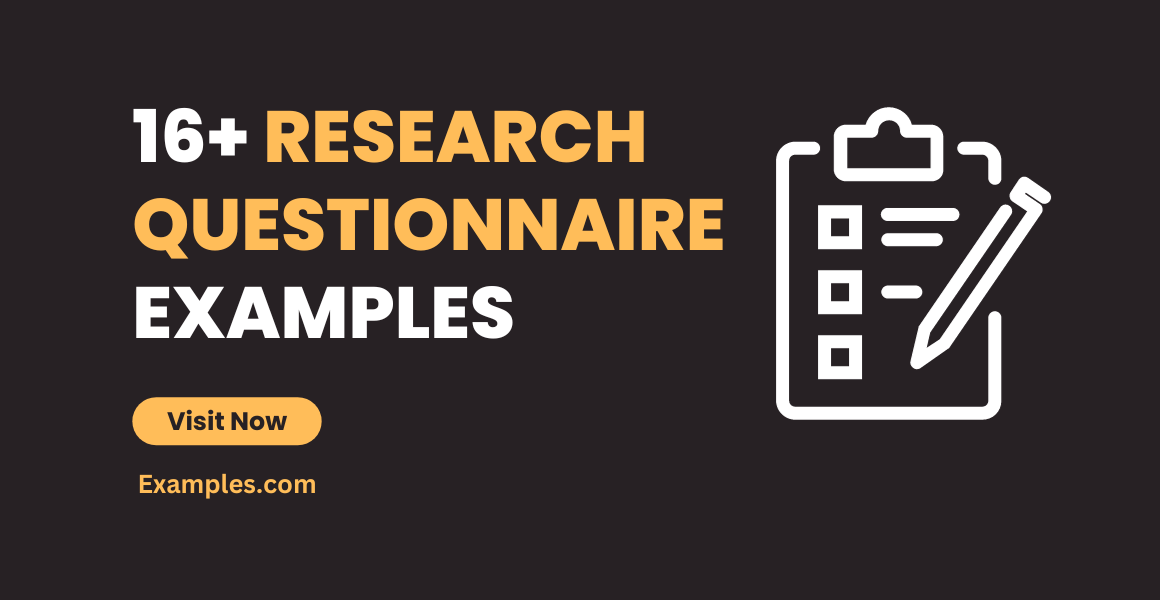
When a researcher creates a research paper using the scientific method they will need to use a gathering method that is adjacent to the research topic. This means that the researcher will use a quantitative research method for a quantitive topic and a qualitative method for a qualitative one. The research questionnaire is one of the quantitative data-gathering methods a researcher can use in their research paper.
1. Market Research Questionnaire Template Example
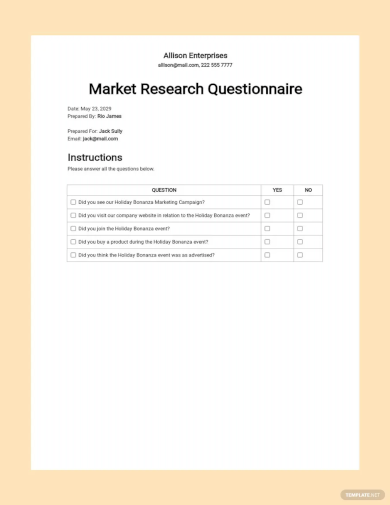
- Google Docs
- Apple Pages
Size: 38 KB
2. Market Research Questionnaire Example
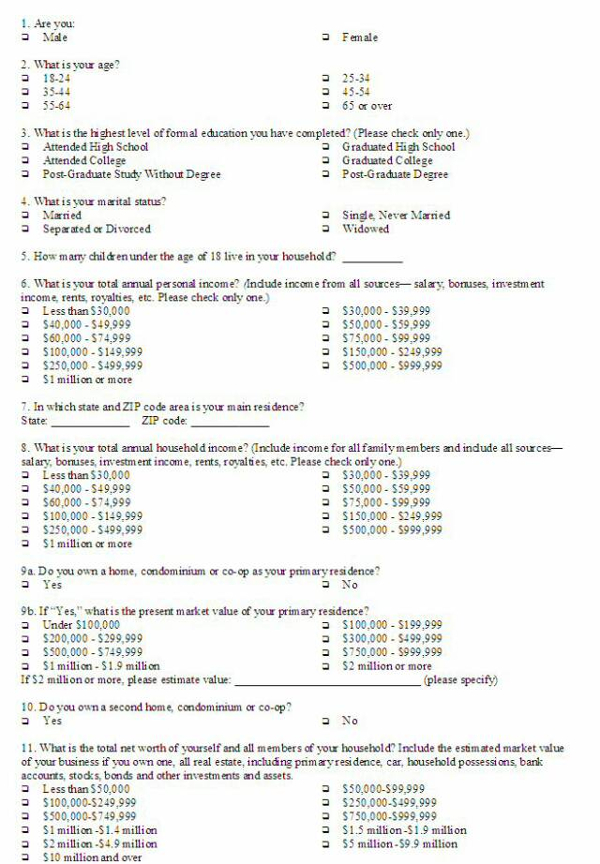
Size: 94 KB
3. Research Questionnaire Example
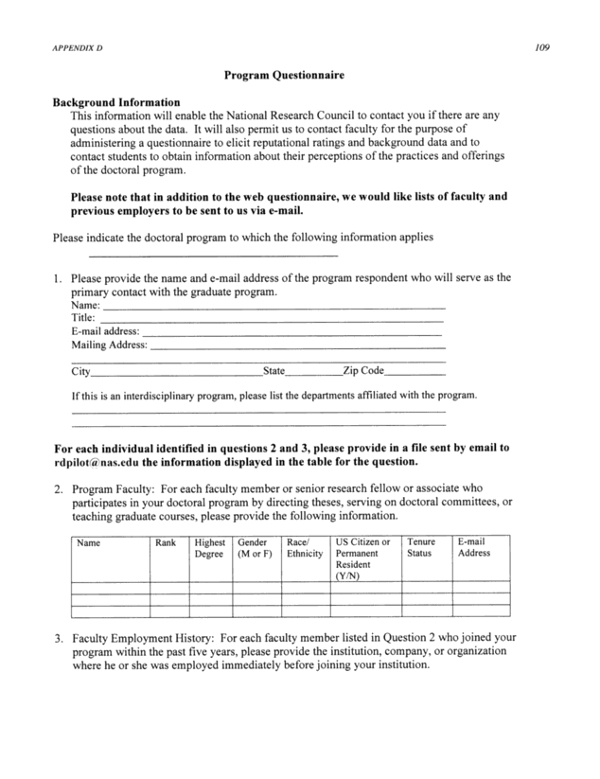
4. Sample Market Research Questionnaire
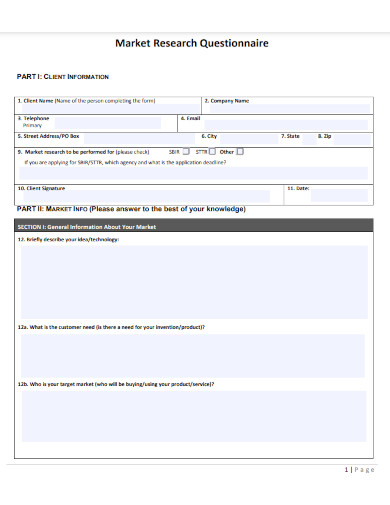
Size: 35 KB
5. Research Survey Questionnaire
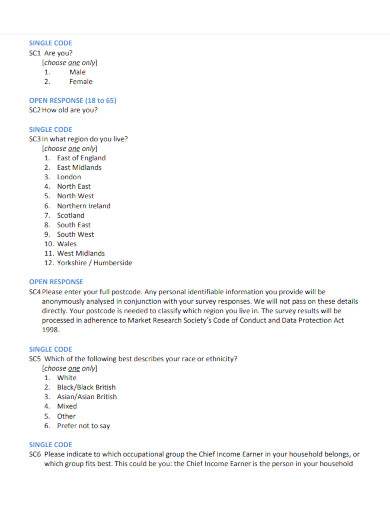
Size: 42 KB
6. Research Survey Questionnaire Construction
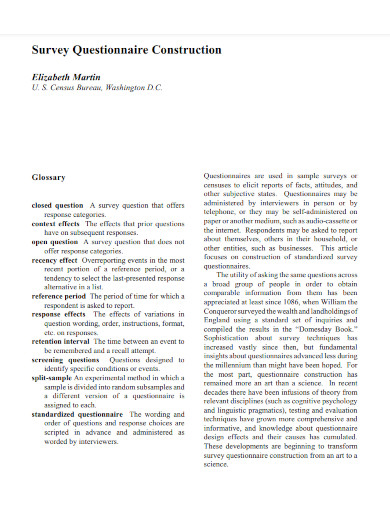
Size: 80 KB
7. Research Questionnaire Survey of Consumers
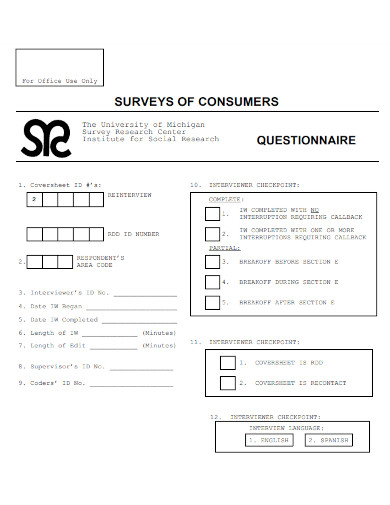
Size: 39 KB
8. Guide to the Design of Research Questionnaires
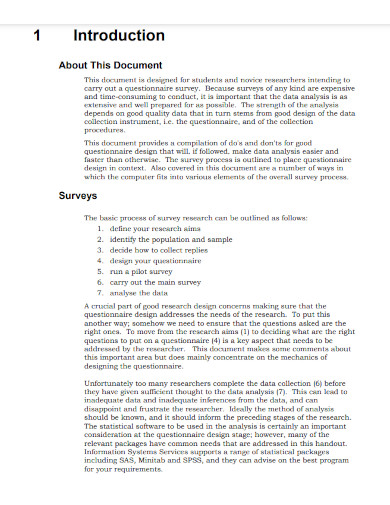
Size: 77 KB
9. Planning Survey Research Questionnaires

Size: 85 KB
10. Climate Change Survey Questionnaires
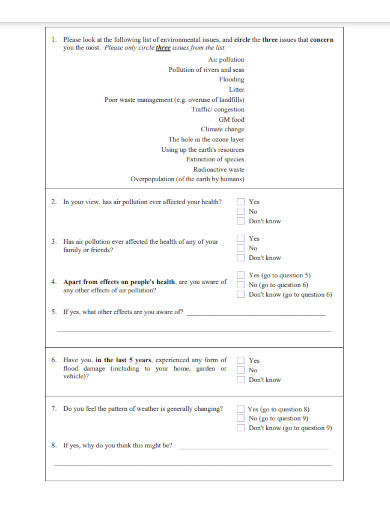
Size: 41 KB
11. Survey Questionnaire Design
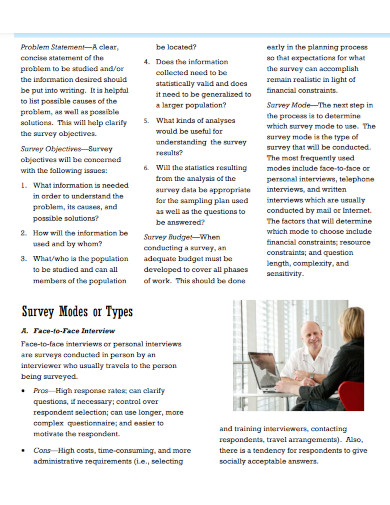
Size: 96 KB
12. Developing Questionnaires for Educational Research
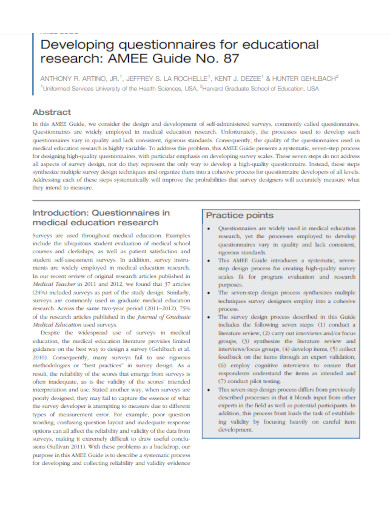
Size: 81 KB
13. Graudate Research Student Questionnaires
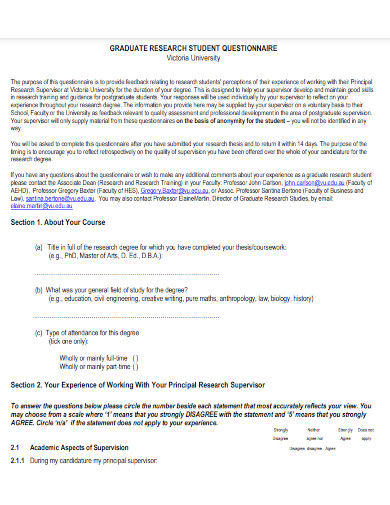
14. Sample Research Survey Questionnaires

Size: 46 KB
15. Market Research Questionnaire Example
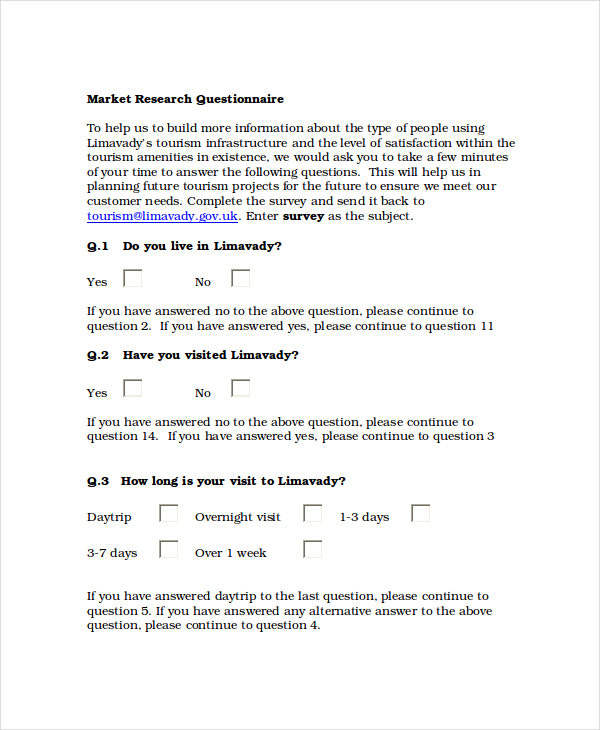
16. Research Survey Questionnaire Example
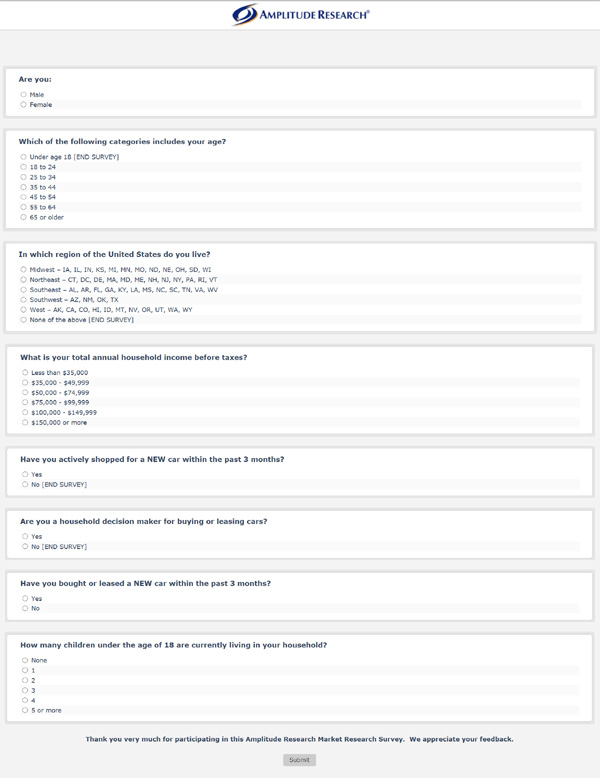
17. Product X Research Study Questionnaire Example
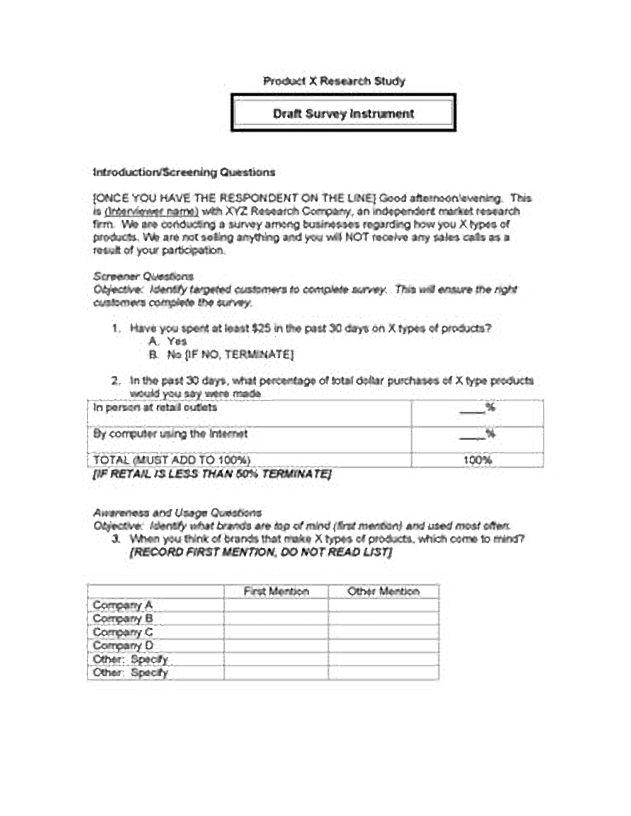

What Is a Research Questionnaire?
A research questionnaire is a physical or digital questionnaire that researchers use to obtain quantitative data. The research questionnaire is a more in-depth version of a survey as its questions often delve deeper than survey questions .
How to Write a Research Questionnaire
A well-made research questionnaire can effectively and efficiently gather data from the population. Creating a good research questionnaire does not require that many writing skills , soft skills , or hard skills , it just requires the person to properly understand the data set they are looking for.
Step 1: Select a Topic or Theme for the Research Questionnaire
Begin by choosing a topic or theme for the research questionnaire as this will provide much-needed context for the research questionnaire. Not only that but the topic will also dictate the tone of the questions in the questionnaire.
Step 2: Obtain or Use a Research Questionnaire Outline
You may opt to use a research questionnaire outline or outline format for your research questionnaire. This outline will provide you with a structure you can use to easily make your research questionnaire.
Step 3: Create your Research Questionnaire
Start by creating questions that will help provide you with the necessary data to prove or disprove your research question. You may conduct brainstorming sessions to formulate the questions for your research questionnaire.
Step 4: Edit and Have Someone Proofread the Questionnaire
After you have created and completed the research questionnaire, you must edit the contents of the questionnaire. Not only that but it is wise to have someone proofread the contents of your questionnaire before deploying the questionnaire.
How does a research questionnaire help businesses?
A successful business or company utilizes research questionnaires to not only obtain data from their customers but also to gather data about the performance and quality of the employees in the business. The research questionnaire provides the business or company with actionable data, which they can use to improve the product, service, or commodity to obtain more customers.
Do I need to provide a consent form when I ask someone to answer the research questionnaire?
Yes, consent is very important as without this the data you have gathered from your questionnaires or surveys are useless. Therefore it is important to provide a consent form with your research questionnaire when you are asking a participant to answer the document.
What type of answers are allowed in the research questionnaire?
Research questionnaires can host a multitude of types of questions each with its specific way of answering. A questionnaire can use multiple-choice questions, open-ended questions, and closed questions. Just be sure to properly pace the questions as having too many different types of answering styles can demotivate or distract the target audience, which might lead to errors.
A research questionnaire is a data-gathering document people can use to obtain information and data from a specific group of people. Well-made and crafted research questionnaires will provide much-needed information one can use to answer a specific research question.
Questionnaire Generator
Text prompt
- Instructive
- Professional
Create a fun quiz to find out which historical figure you're most like in your study habits
Design a survey to discover students' favorite school subjects and why they love them.
Product Overview
SurveyMonkey is built to handle every use case and need. Explore our product to learn how SurveyMonkey can work for you.
SurveyMonkey
Get data-driven insights from a global leader in online surveys.
Integrations
Integrate with 100+ apps and plug-ins to get more done.
SurveyMonkey Forms
Build and customize online forms to collect info and payments.
SurveyMonkey Genius
Create better surveys and spot insights quickly with built-in AI.
Market Research Solutions
Purpose-built solutions for all of your market research needs.
Financial Services
See more industries, customer experience, human resources, see more roles.
Online Polls
Registration Forms
Employee feedback, event feedback, customer satisfaction, see more use cases.
Contact Sales
Net Promoter Score
Measure customer satisfaction and loyalty for your business.
Learn what makes customers happy and turn them into advocates.
Website Feedback
Get actionable insights to improve the user experience.
Contact Information
Collect contact information from prospects, invitees, and more.
Event Registration
Easily collect and track RSVPs for your next event.
Find out what attendees want so that you can improve your next event.
Employee Engagement
Uncover insights to boost engagement and drive better results.
Meeting Feedback
Get feedback from your attendees so you can run better meetings.
360-degree employee evaluation
Use peer feedback to help improve employee performance.
Course Evaluation
Create better courses and improve teaching methods.
University Instructor Evaluation
Learn how students rate the course material and its presentation.
Product Testing
Find out what your customers think about your new product ideas.
See all templates
Resource center.
Best practices for using surveys and survey data
Curiosity at Work Blog
Our blog about surveys, tips for business, and more.
Help Center
Tutorials and how to guides for using SurveyMonkey.
How top brands drive growth with SurveyMonkey.
- English (US)
- English (UK)
Questionnaire examples and sample templates
Do you want to write a survey questionnaire, but need a little guidance on the right questions to use? Well you’re in the right place! Our pre-written survey templates make it easy to pick through a series of questions, understand the difference between open questions and closed questions, build your survey, and start collecting data in minutes.
Search our library of sample survey questionnaires
Filter by survey type.
All our sample survey template questions are expert-certified by professional survey methodologists to make sure you ask questions the right way–and get reliable results. You can send out our templates as is, choose separate variables, add additional questions, or customize our questionnaire templates to fit your needs.
How else can a sample survey help you? Our sample survey examples—or customizable survey templates that span every use case, can allow you to overcome writer’s block and help you identify the questions you want to ask the most. Plus, by looking through an example of a survey, you’ll get a sense for the question types you can use, how you can order the questions, and the ways you can apply survey logic .
Discover more resources

Toolkits directory
Discover our toolkits, designed to help you leverage feedback in your role or industry.

Likert scale examples, survey questions, and common mistakes to avoid
Explore Likert scale questions, examples, and common pitfalls to avoid in your next survey.

Make every survey count: how to increase your reach and collect better data
Learn how to send your survey to maximize survey responses and get more from your insights.

Get the feedback you can act on with online evaluation forms
Unlock the power of feedback with SurveyMonkey's online evaluation forms. Start with our form builder today!
Didn’t see the questionnaire you were looking for?
We make it easy to create your own survey from scratch and get reliable, standardized answers.
Our list of sample survey questionnaires:
App Directory
Vision and Mission
SurveyMonkey Together
Diversity, Equity & Inclusion
Health Plan Transparency in Coverage
Office Locations
Terms of Use
Privacy Notice
California Privacy Notice
Acceptable Uses Policy
Security Statement
GDPR Compliance
Email Opt-In
Accessibility
Cookies Notice
Facebook Surveys
Survey Template
Scheduling Polls
Google Forms vs. SurveyMonkey
Employee Satisfaction Surveys
Free Survey Templates
Mobile Surveys
How to Improve Customer Service
AB Test Significance Calculator
NPS Calculator
Questionnaire Templates
Event Survey
Sample Size Calculator
Writing Good Surveys
Likert Scale
Survey Analysis
360 Degree Feedback
Education Surveys
Survey Questions
NPS Calculation
Customer Satisfaction Survey Questions
Agree Disagree Questions
Create a Survey
Online Quizzes
Qualitative vs Quantitative Research
Customer Survey
Market Research Surveys
Survey Design Best Practices
Margin of Error Calculator
Questionnaire
Demographic Questions
Training Survey
Offline Survey
360 Review Template
Have a language expert improve your writing
Run a free plagiarism check in 10 minutes, automatically generate references for free.
- Knowledge Base
- Methodology
- Questionnaire Design | Methods, Question Types & Examples
Questionnaire Design | Methods, Question Types & Examples
Published on 6 May 2022 by Pritha Bhandari . Revised on 10 October 2022.
A questionnaire is a list of questions or items used to gather data from respondents about their attitudes, experiences, or opinions. Questionnaires can be used to collect quantitative and/or qualitative information.
Questionnaires are commonly used in market research as well as in the social and health sciences. For example, a company may ask for feedback about a recent customer service experience, or psychology researchers may investigate health risk perceptions using questionnaires.
Table of contents
Questionnaires vs surveys, questionnaire methods, open-ended vs closed-ended questions, question wording, question order, step-by-step guide to design, frequently asked questions about questionnaire design.
A survey is a research method where you collect and analyse data from a group of people. A questionnaire is a specific tool or instrument for collecting the data.
Designing a questionnaire means creating valid and reliable questions that address your research objectives, placing them in a useful order, and selecting an appropriate method for administration.
But designing a questionnaire is only one component of survey research. Survey research also involves defining the population you’re interested in, choosing an appropriate sampling method , administering questionnaires, data cleaning and analysis, and interpretation.
Sampling is important in survey research because you’ll often aim to generalise your results to the population. Gather data from a sample that represents the range of views in the population for externally valid results. There will always be some differences between the population and the sample, but minimising these will help you avoid sampling bias .
Prevent plagiarism, run a free check.
Questionnaires can be self-administered or researcher-administered . Self-administered questionnaires are more common because they are easy to implement and inexpensive, but researcher-administered questionnaires allow deeper insights.
Self-administered questionnaires
Self-administered questionnaires can be delivered online or in paper-and-pen formats, in person or by post. All questions are standardised so that all respondents receive the same questions with identical wording.
Self-administered questionnaires can be:
- Cost-effective
- Easy to administer for small and large groups
- Anonymous and suitable for sensitive topics
But they may also be:
- Unsuitable for people with limited literacy or verbal skills
- Susceptible to a nonreponse bias (most people invited may not complete the questionnaire)
- Biased towards people who volunteer because impersonal survey requests often go ignored
Researcher-administered questionnaires
Researcher-administered questionnaires are interviews that take place by phone, in person, or online between researchers and respondents.
Researcher-administered questionnaires can:
- Help you ensure the respondents are representative of your target audience
- Allow clarifications of ambiguous or unclear questions and answers
- Have high response rates because it’s harder to refuse an interview when personal attention is given to respondents
But researcher-administered questionnaires can be limiting in terms of resources. They are:
- Costly and time-consuming to perform
- More difficult to analyse if you have qualitative responses
- Likely to contain experimenter bias or demand characteristics
- Likely to encourage social desirability bias in responses because of a lack of anonymity
Your questionnaire can include open-ended or closed-ended questions, or a combination of both.
Using closed-ended questions limits your responses, while open-ended questions enable a broad range of answers. You’ll need to balance these considerations with your available time and resources.
Closed-ended questions
Closed-ended, or restricted-choice, questions offer respondents a fixed set of choices to select from. Closed-ended questions are best for collecting data on categorical or quantitative variables.
Categorical variables can be nominal or ordinal. Quantitative variables can be interval or ratio. Understanding the type of variable and level of measurement means you can perform appropriate statistical analyses for generalisable results.
Examples of closed-ended questions for different variables
Nominal variables include categories that can’t be ranked, such as race or ethnicity. This includes binary or dichotomous categories.
It’s best to include categories that cover all possible answers and are mutually exclusive. There should be no overlap between response items.
In binary or dichotomous questions, you’ll give respondents only two options to choose from.
White Black or African American American Indian or Alaska Native Asian Native Hawaiian or Other Pacific Islander
Ordinal variables include categories that can be ranked. Consider how wide or narrow a range you’ll include in your response items, and their relevance to your respondents.
Likert-type questions collect ordinal data using rating scales with five or seven points.
When you have four or more Likert-type questions, you can treat the composite data as quantitative data on an interval scale . Intelligence tests, psychological scales, and personality inventories use multiple Likert-type questions to collect interval data.
With interval or ratio data, you can apply strong statistical hypothesis tests to address your research aims.
Pros and cons of closed-ended questions
Well-designed closed-ended questions are easy to understand and can be answered quickly. However, you might still miss important answers that are relevant to respondents. An incomplete set of response items may force some respondents to pick the closest alternative to their true answer. These types of questions may also miss out on valuable detail.
To solve these problems, you can make questions partially closed-ended, and include an open-ended option where respondents can fill in their own answer.
Open-ended questions
Open-ended, or long-form, questions allow respondents to give answers in their own words. Because there are no restrictions on their choices, respondents can answer in ways that researchers may not have otherwise considered. For example, respondents may want to answer ‘multiracial’ for the question on race rather than selecting from a restricted list.
- How do you feel about open science?
- How would you describe your personality?
- In your opinion, what is the biggest obstacle to productivity in remote work?
Open-ended questions have a few downsides.
They require more time and effort from respondents, which may deter them from completing the questionnaire.
For researchers, understanding and summarising responses to these questions can take a lot of time and resources. You’ll need to develop a systematic coding scheme to categorise answers, and you may also need to involve other researchers in data analysis for high reliability .
Question wording can influence your respondents’ answers, especially if the language is unclear, ambiguous, or biased. Good questions need to be understood by all respondents in the same way ( reliable ) and measure exactly what you’re interested in ( valid ).
Use clear language
You should design questions with your target audience in mind. Consider their familiarity with your questionnaire topics and language and tailor your questions to them.
For readability and clarity, avoid jargon or overly complex language. Don’t use double negatives because they can be harder to understand.
Use balanced framing
Respondents often answer in different ways depending on the question framing. Positive frames are interpreted as more neutral than negative frames and may encourage more socially desirable answers.
Use a mix of both positive and negative frames to avoid bias , and ensure that your question wording is balanced wherever possible.
Unbalanced questions focus on only one side of an argument. Respondents may be less likely to oppose the question if it is framed in a particular direction. It’s best practice to provide a counterargument within the question as well.
Avoid leading questions
Leading questions guide respondents towards answering in specific ways, even if that’s not how they truly feel, by explicitly or implicitly providing them with extra information.
It’s best to keep your questions short and specific to your topic of interest.
- The average daily work commute in the US takes 54.2 minutes and costs $29 per day. Since 2020, working from home has saved many employees time and money. Do you favour flexible work-from-home policies even after it’s safe to return to offices?
- Experts agree that a well-balanced diet provides sufficient vitamins and minerals, and multivitamins and supplements are not necessary or effective. Do you agree or disagree that multivitamins are helpful for balanced nutrition?
Keep your questions focused
Ask about only one idea at a time and avoid double-barrelled questions. Double-barrelled questions ask about more than one item at a time, which can confuse respondents.
This question could be difficult to answer for respondents who feel strongly about the right to clean drinking water but not high-speed internet. They might only answer about the topic they feel passionate about or provide a neutral answer instead – but neither of these options capture their true answers.
Instead, you should ask two separate questions to gauge respondents’ opinions.
Strongly Agree Agree Undecided Disagree Strongly Disagree
Do you agree or disagree that the government should be responsible for providing high-speed internet to everyone?
You can organise the questions logically, with a clear progression from simple to complex. Alternatively, you can randomise the question order between respondents.
Logical flow
Using a logical flow to your question order means starting with simple questions, such as behavioural or opinion questions, and ending with more complex, sensitive, or controversial questions.
The question order that you use can significantly affect the responses by priming them in specific directions. Question order effects, or context effects, occur when earlier questions influence the responses to later questions, reducing the validity of your questionnaire.
While demographic questions are usually unaffected by order effects, questions about opinions and attitudes are more susceptible to them.
- How knowledgeable are you about Joe Biden’s executive orders in his first 100 days?
- Are you satisfied or dissatisfied with the way Joe Biden is managing the economy?
- Do you approve or disapprove of the way Joe Biden is handling his job as president?
It’s important to minimise order effects because they can be a source of systematic error or bias in your study.
Randomisation
Randomisation involves presenting individual respondents with the same questionnaire but with different question orders.
When you use randomisation, order effects will be minimised in your dataset. But a randomised order may also make it harder for respondents to process your questionnaire. Some questions may need more cognitive effort, while others are easier to answer, so a random order could require more time or mental capacity for respondents to switch between questions.
Follow this step-by-step guide to design your questionnaire.
Step 1: Define your goals and objectives
The first step of designing a questionnaire is determining your aims.
- What topics or experiences are you studying?
- What specifically do you want to find out?
- Is a self-report questionnaire an appropriate tool for investigating this topic?
Once you’ve specified your research aims, you can operationalise your variables of interest into questionnaire items. Operationalising concepts means turning them from abstract ideas into concrete measurements. Every question needs to address a defined need and have a clear purpose.
Step 2: Use questions that are suitable for your sample
Create appropriate questions by taking the perspective of your respondents. Consider their language proficiency and available time and energy when designing your questionnaire.
- Are the respondents familiar with the language and terms used in your questions?
- Would any of the questions insult, confuse, or embarrass them?
- Do the response items for any closed-ended questions capture all possible answers?
- Are the response items mutually exclusive?
- Do the respondents have time to respond to open-ended questions?
Consider all possible options for responses to closed-ended questions. From a respondent’s perspective, a lack of response options reflecting their point of view or true answer may make them feel alienated or excluded. In turn, they’ll become disengaged or inattentive to the rest of the questionnaire.
Step 3: Decide on your questionnaire length and question order
Once you have your questions, make sure that the length and order of your questions are appropriate for your sample.
If respondents are not being incentivised or compensated, keep your questionnaire short and easy to answer. Otherwise, your sample may be biased with only highly motivated respondents completing the questionnaire.
Decide on your question order based on your aims and resources. Use a logical flow if your respondents have limited time or if you cannot randomise questions. Randomising questions helps you avoid bias, but it can take more complex statistical analysis to interpret your data.
Step 4: Pretest your questionnaire
When you have a complete list of questions, you’ll need to pretest it to make sure what you’re asking is always clear and unambiguous. Pretesting helps you catch any errors or points of confusion before performing your study.
Ask friends, classmates, or members of your target audience to complete your questionnaire using the same method you’ll use for your research. Find out if any questions were particularly difficult to answer or if the directions were unclear or inconsistent, and make changes as necessary.
If you have the resources, running a pilot study will help you test the validity and reliability of your questionnaire. A pilot study is a practice run of the full study, and it includes sampling, data collection , and analysis.
You can find out whether your procedures are unfeasible or susceptible to bias and make changes in time, but you can’t test a hypothesis with this type of study because it’s usually statistically underpowered .
A questionnaire is a data collection tool or instrument, while a survey is an overarching research method that involves collecting and analysing data from people using questionnaires.
Closed-ended, or restricted-choice, questions offer respondents a fixed set of choices to select from. These questions are easier to answer quickly.
Open-ended or long-form questions allow respondents to answer in their own words. Because there are no restrictions on their choices, respondents can answer in ways that researchers may not have otherwise considered.
A Likert scale is a rating scale that quantitatively assesses opinions, attitudes, or behaviours. It is made up of four or more questions that measure a single attitude or trait when response scores are combined.
To use a Likert scale in a survey , you present participants with Likert-type questions or statements, and a continuum of items, usually with five or seven possible responses, to capture their degree of agreement.
You can organise the questions logically, with a clear progression from simple to complex, or randomly between respondents. A logical flow helps respondents process the questionnaire easier and quicker, but it may lead to bias. Randomisation can minimise the bias from order effects.
Questionnaires can be self-administered or researcher-administered.
Researcher-administered questionnaires are interviews that take place by phone, in person, or online between researchers and respondents. You can gain deeper insights by clarifying questions for respondents or asking follow-up questions.
Cite this Scribbr article
If you want to cite this source, you can copy and paste the citation or click the ‘Cite this Scribbr article’ button to automatically add the citation to our free Reference Generator.
Bhandari, P. (2022, October 10). Questionnaire Design | Methods, Question Types & Examples. Scribbr. Retrieved 9 April 2024, from https://www.scribbr.co.uk/research-methods/questionnaire-design/
Is this article helpful?

Pritha Bhandari
Other students also liked, doing survey research | a step-by-step guide & examples, what is a likert scale | guide & examples, reliability vs validity in research | differences, types & examples.
38+ SAMPLE Research Checklist in PDF | MS Word
Research checklist | ms word, 38+ sample research checklist, what is a research checklist, importance of research, advantages of checklist in research, how to write a research checklist, what are the five checklist components of a research paper, what are the different types of a checklist, can a checklist be used for the qualitative study.
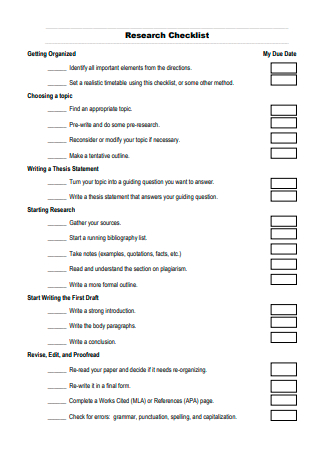
Research Checklist Template

Research Paper Checklist
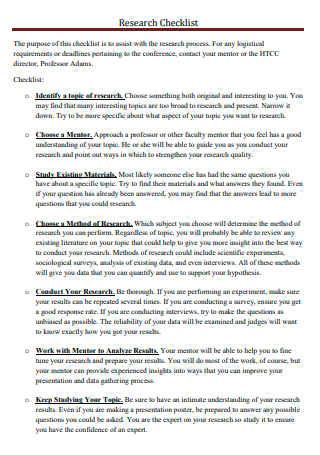
Basic Research Checklist
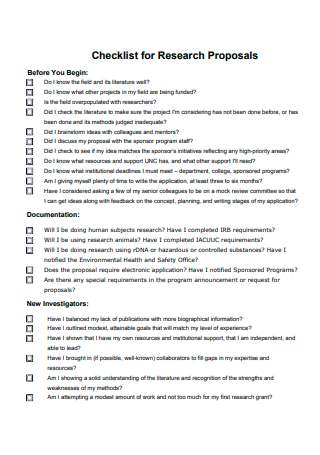
Research Proposal Checklist
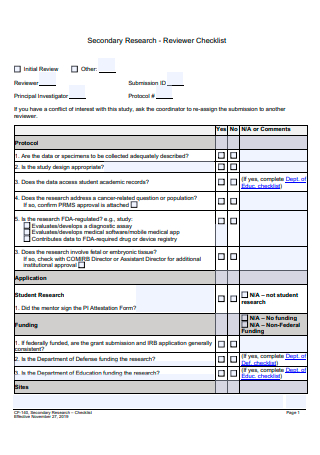
Secondary Research Reviewer Checklist
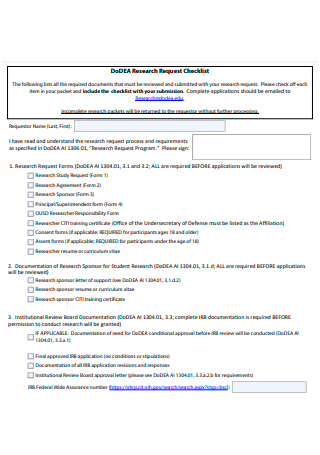
Research Request Checklist
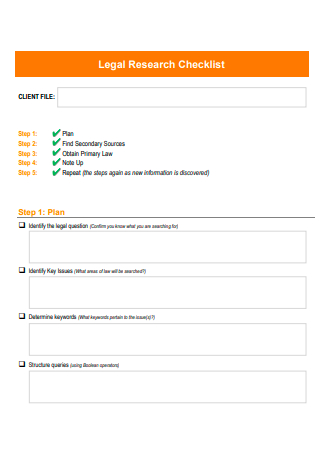
Legal Research Checklist
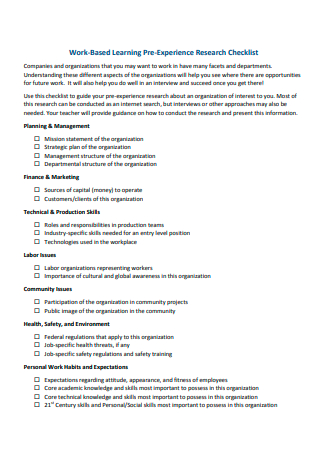
Work Based Learning Pre-Experience Research Checklist
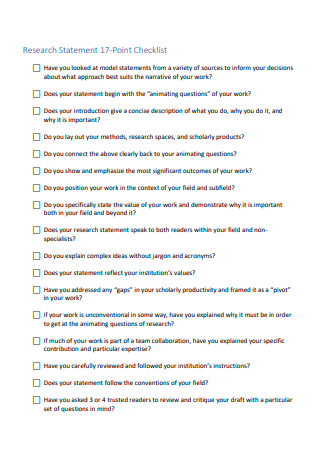
Research Statement Checklist
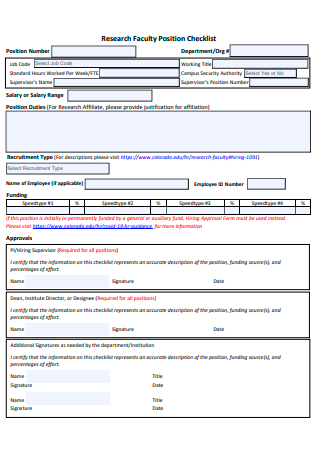
Research Faculty Position Checklist
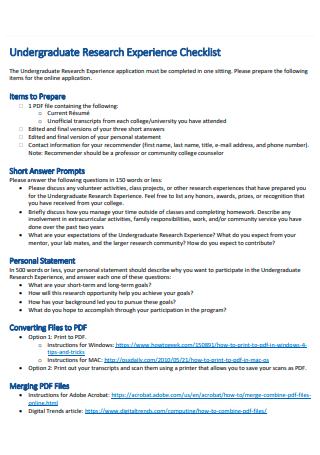
Undergraduate Research Experience Checklist
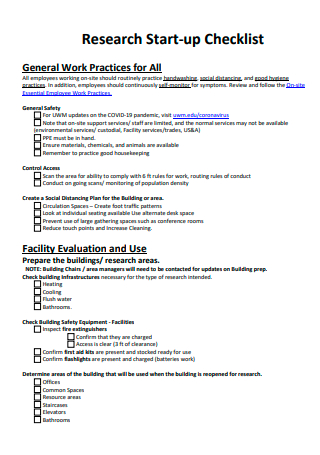
Research Start up Checklist

Clinical Research Checklist
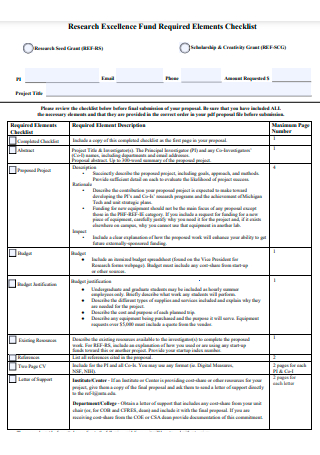
Research Excellence Fund Required Elements Checklist

Emergency Research Checklist
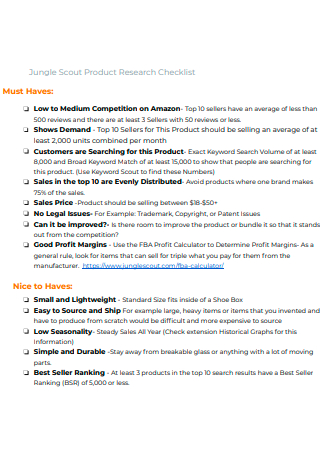
Product Research Checklist
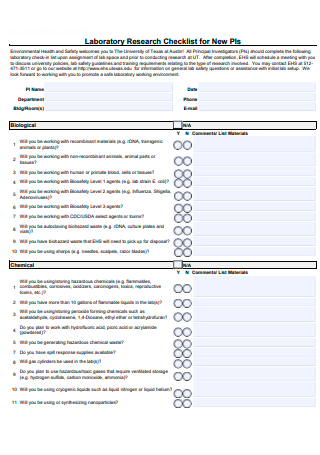
Laboratory Research Checklist
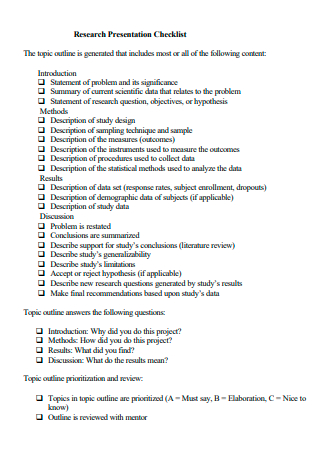
Research Presentation Checklist
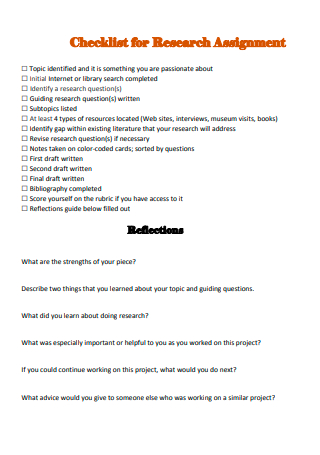
Research Assignment Checklist
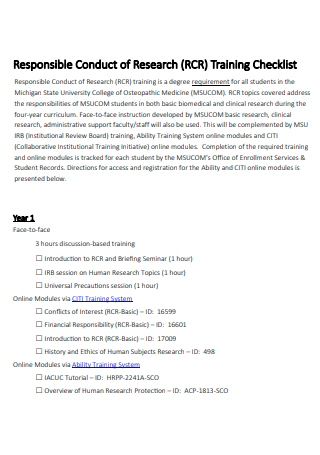
Research Training Checklist
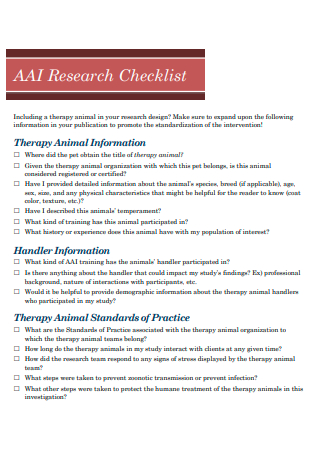
Research Checklist Example

Covid-19 Research Checklist
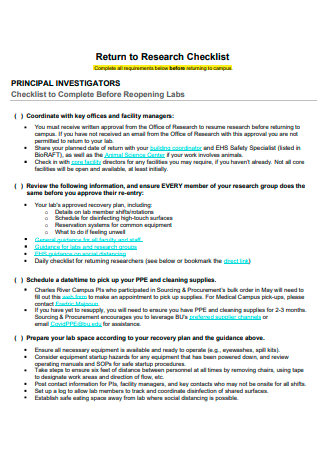
Return to Research Checklist
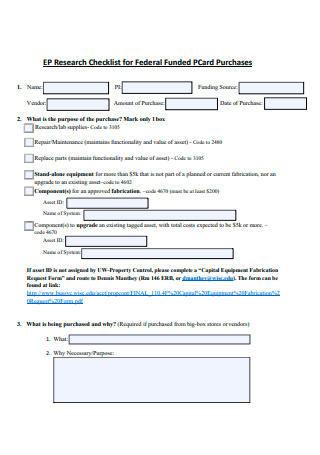
Federal Funded Purchases Research Checklist
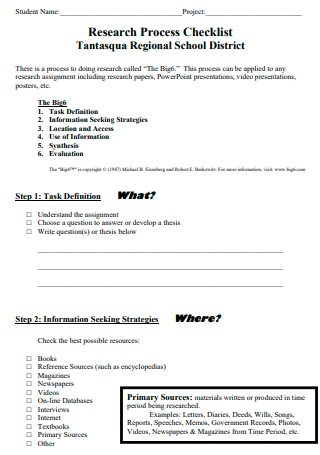
Research Process Checklist
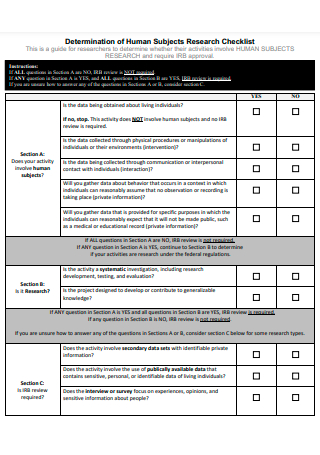
Human Research Checklist
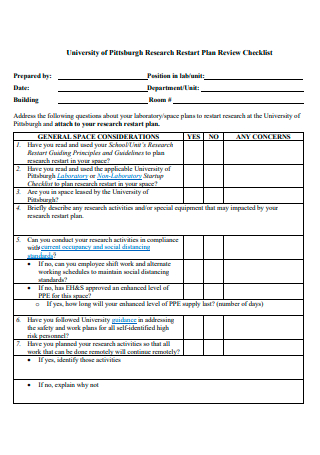
Research Restart Plan Review Checklist
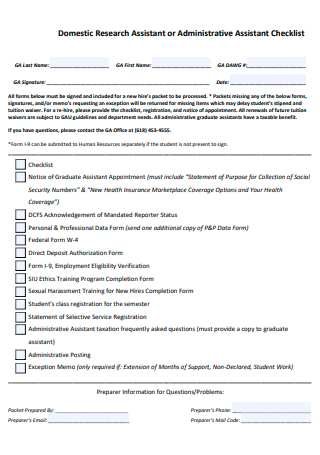
Domestic Research Administrative Assistant Checklist
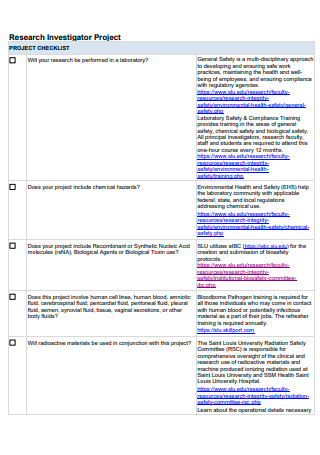
Research Investigator Project Checklist
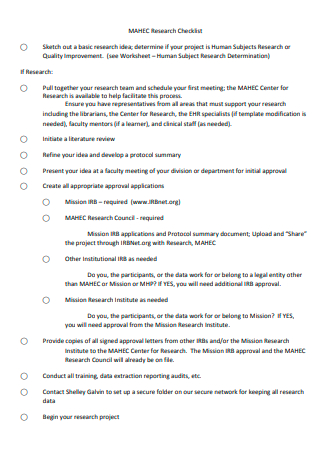
Formal Research Checklist
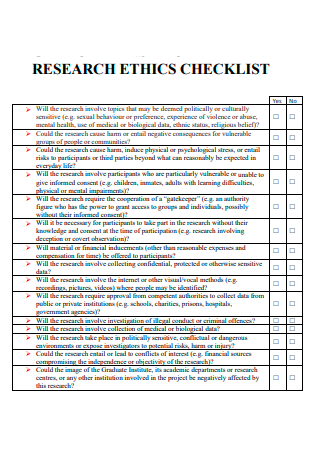
Research Ethics Checklist
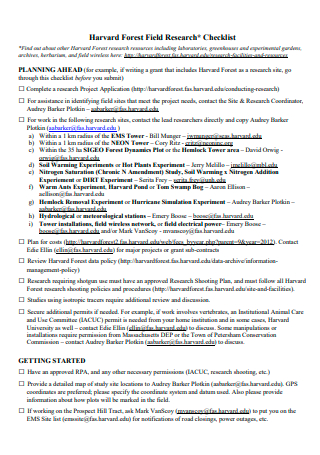
Forest Field Research Checklist
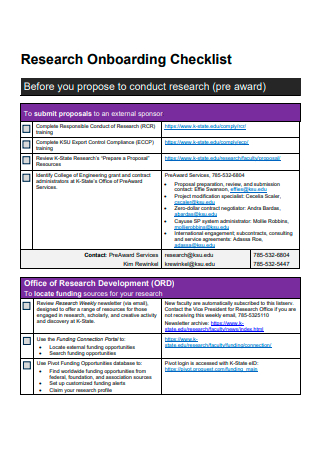
Research Onboarding Checklist
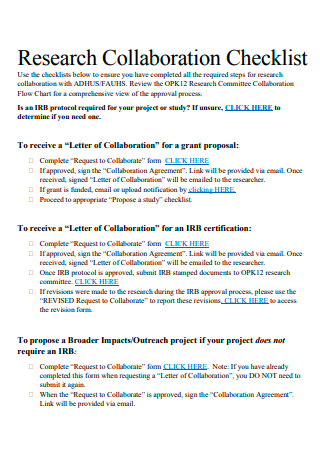
Research Collaboration Checklist
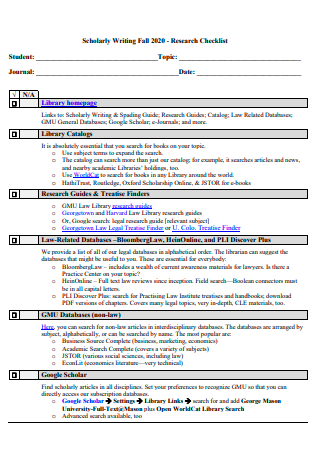
Research Checklist in PDF

Classroom Research Project Checklist
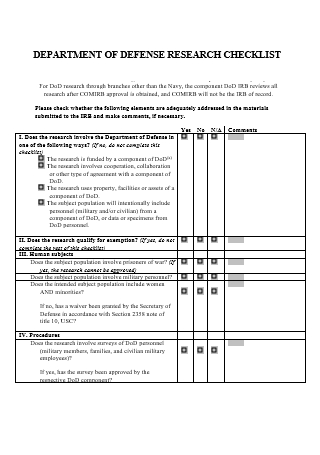
Department of Defense Research Checklist
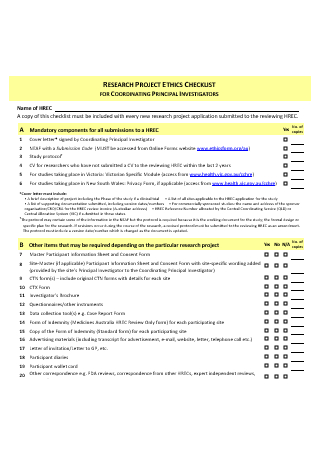
Research Project Ethics Checklist
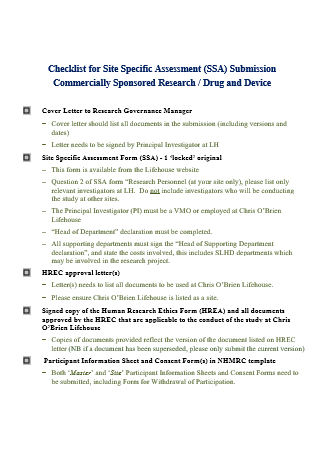
Research Checklist in DOC
1. define the topic, 2. list down your sources, 3. synthesize your research, 4. add boxes, share this post on your network, file formats, word templates, google docs templates, excel templates, powerpoint templates, google sheets templates, google slides templates, pdf templates, publisher templates, psd templates, indesign templates, illustrator templates, pages templates, keynote templates, numbers templates, outlook templates, you may also like these articles, 3+ sample vendor audit checklist in pdf.
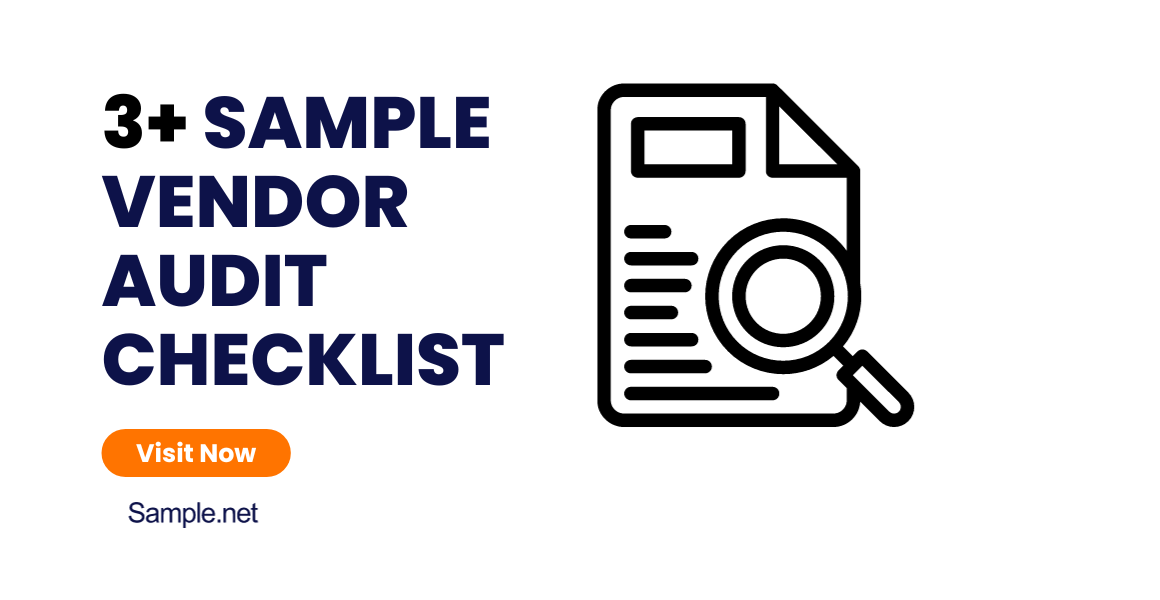
Kathy Burlison once said, “Given the risks of an expensive audit, paying strict attention to the rules is the only smart decision you can make.” Since the term audit…
18+ SAMPLE Food Safety Inspection Checklist in PDF
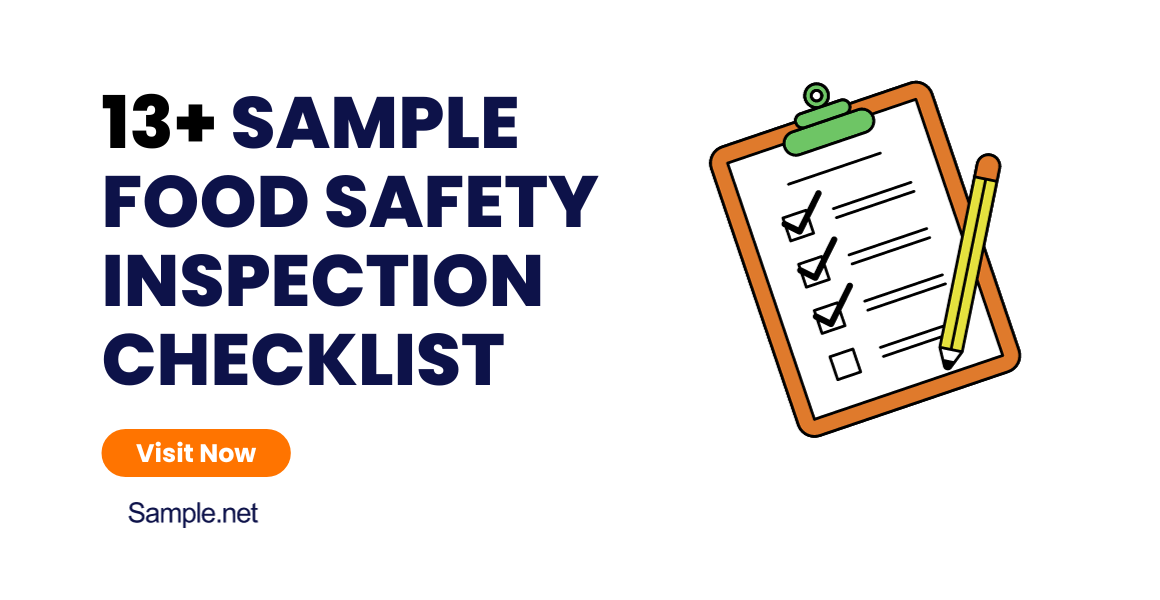
The food industry is one of the most dominant and flourishing industries present in the status quo. With that, food companies are doing their best to keep their products…
browse by categories
- Questionnaire
- Description
- Reconciliation
- Certificate
- Spreadsheet
Information
- privacy policy
- Terms & Conditions

IMAGES
VIDEO
COMMENTS
Learn how to design a questionnaire for your research project, including methods, question types, wording, order, and design tips. See examples of different types of questions and how to use them for different variables and purposes. Find out the pros and cons of open-ended and closed-ended questions, and how to choose the best method for your research.
22.1. Make sections meaningful and helpful to respondents: Section headings should be brief, to the point, and should clearly identify the section's content. For Web Questionnaires - If a section heading repeats for more than one screen, repeat the section heading text followed by the word "Continued.". 22.2.
1. Early questions should be easy and pleasant to answer, and should build rapport between the respondent and the researcher. 2. Questions at the very beginning of a questionnaire should explicitly address the topic of the survey, as it was described to the respondent prior to the interview. 3. Questions on the same topic should be grouped ...
The following questionnaire checklist includes three sections: the outline and format. the questions and. pre-test or pilot testing. You may print this and place a checkmark if you think you have successfully accomplished each item on the checklist. 1. The Outline and Format.
Table E on bmj.com gives a critical appraisal checklist for evaluating questionnaire studies. In the following two articles we will discuss how to select a sample, pilot and administer a questionnaire, and analyse data and approaches for groups that are hard to research. ... Numerous research students and conference delegates provided ...
However, the quality and accuracy of data collected using a questionnaire depend on how it is designed, used, and validated. In this two-part series, we discuss how to design (part 1) and how to use and validate (part 2) a research questionnaire. It is important to emphasize that questionnaires seek to gather information from other people and ...
Definition: A Questionnaire is a research tool or survey instrument that consists of a set of questions or prompts designed to gather information from individuals or groups of people. It is a standardized way of collecting data from a large number of people by asking them a series of questions related to a specific topic or research objective.
writing questions and building the construct of the questionnaire. It also develops the demand to pre-test the questionnaire and finalizing the questionnaire to conduct the survey. Keywords: Questionnaire, Academic Survey, Questionnaire Design, Research Methodology I. INTRODUCTION A questionnaire, as heart of the survey is based on a set of
A questionnaire is an important instrument in a research study to help the researcher collect relevant data regarding the research topic. It is significant to ensure that the design of the ...
A questionnaire is defined a market research instrument that consists of questions or prompts to elicit and collect responses from a sample of respondents. This article enlists 21 questionnaire templates along with samples and examples. It also describes the different types of questionnaires and the question types that are used in these ...
If the study is mixed methods, do the research questions and/or hypotheses do the following? • Include the characteristics of a good qualitative research question (as listed above) • Include the characteristics of a good quantitative research and/or hypothesis (as listed above) • Indicate how the researcher will mix or integrate the two ...
☑ How you will reach your sample. ☑ How you plan to control your biases. ☑ How you might develop the skills/resources needed to carry out your survey, i.e.) statistics proficiency. ☑ Ethics/ethics approval. ☑ The aspects of your research question that can be answered through a questionnaire.
A questionnaire checklist example can guide you so that you will have ideas on how to create a good checklist. A template has a questionnaire checklist format that can help you make the right checklist. With a template, you will know what it takes to have a good checklist. It can make your work easier. You will be given proper instructions.
The first question asks for a ready-made solution, and is not focused or researchable. The second question is a clearer comparative question, but note that it may not be practically feasible. For a smaller research project or thesis, it could be narrowed down further to focus on the effectiveness of drunk driving laws in just one or two countries.
The research questionnaire is one of the quantitative data-gathering methods a researcher can use in their research paper. 1. Market Research Questionnaire Template Example. Details. File Format. Size: 38 KB. Download. 2. Market Research Questionnaire Example.
Filter by survey type. All our sample survey template questions are expert-certified by professional survey methodologists to make sure you ask questions the right way-and get reliable results. You can send out our templates as is, choose separate variables, add additional questions, or customize our questionnaire templates to fit your needs.
A research questionnaire is a tool that consists of a series of standardized questions with the intent of collecting information from a sample of people. Think of it as a kind of written interview that follows a fixed scheme to ensure that data remains accurate.
Ethical approval by an appropriate body. A statement on the ethical approval process followed should be in the report. 10. Relationship of conclusions to analysis, or interpretation of the data. This criterion concerns the relationship between the findings reported and the views or words of study participants.
Revised on 10 October 2022. A questionnaire is a list of questions or items used to gather data from respondents about their attitudes, experiences, or opinions. Questionnaires can be used to collect quantitative and/or qualitative information. Questionnaires are commonly used in market research as well as in the social and health sciences.
An example of a research checklist is available within the article as a means for additional reference. Importance of Research. There is always more to learn, no matter what area of work you are in or how high up you are. ... Take note of the targeted research questions you had thought of during this initial process. 3. Synthesize Your Research.
Sample of a questionnaire in research republic of the philippines department of education region iv (calabarzon) division of rizal morong national high school. ... Research english; Questionnaire- Checklist about Chicken BALL WITH Melted Cheese Sauce; Chapter-2 of a research about Churros;